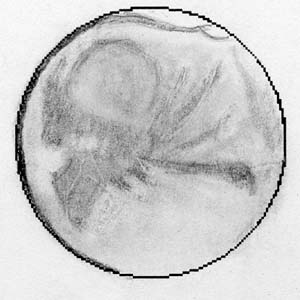
Sketched August 6, 2003 from my back deck 3:15 a.m. pacific DST (daylight savings time) or 10:15 UT. Good observing conditions, some passing clouds in the distance from 2:15 a.m. to 3:15 a.m. It had been over a week since I had been able to observe and sketch Mars due to clouds and vacation, so I sketched this version an hour after the previous one. Not much difference in 14 degrees of Mars rotation, but it had been a long cloudy spell.
| Date: 08/6/03 Lat 37N, Long 122W, elev. 200 feet | Sketch Time (UT): 10:15, (local time): 3:15 a.m. DST |
| Central Meridian: 315° | Filters: none |
| Instrument: 4-inch (105mm) f/6 Astro-Physics Traveler Apo refractor. | Distance from earth 0.40 AU, 60m km, 37m miles |
| Magnification: (4mm) 376x Zeiss Abbe Orthos combined with a 2.4x AP Barcon Barlow | Transp. 4/6, Seeing 6/10, Antoniadi (I-V): II |
| Apparent Size: 23.1" | Magnitude: -2.5 |
Mars, in this sketch is reversed N/S. South is shown at the top of the image. The south polar cap is the prominent feature although it is shrinking dramatically. Other interesting features are the great basin, Hellas below (north) of the south polar cap. The angular dark feature below Hellas is Syrtis Major, and between it and the terminator is whiteish Libya. The long dark feature crossing east to west (left to right) is Sinus Sabaeus and Sinus Meridiani, on the zero meridian. West of Syrtis Major are Aeria, Arabia and Eden, large desert features on Mars. The terminator is where daylight ends and evening begins, and the phase, nearing opposition is 97% illuminated right now. The terminator is on the left and the planet is rotating left to right. In my sketches the planet rotates Martian east (left) to west (right) to match most other images and sketches. Look for features rotating from left to right in the drawings from night to night.
Details about Mars: Diameter 23 arc seconds (Jupiter is about 30 -50 arc seconds in diameter depending on its distance from earth). Central Meridian 315 - the imaginary line passing through the planetary poles of rotation and bisecting the planetary disk, and is used to determine the longitude during an observing session.

White Oaks Home | Sketches Index | Mars 2003 Index | Back | Next